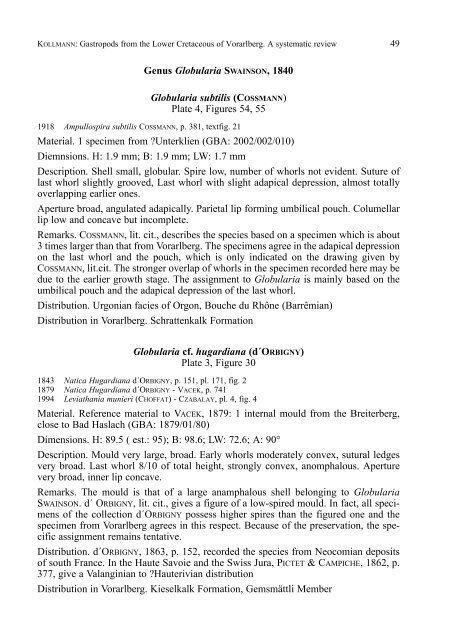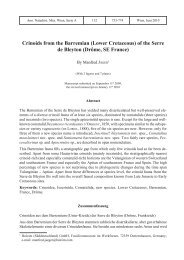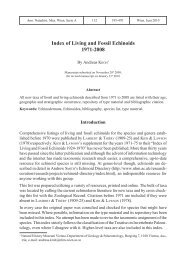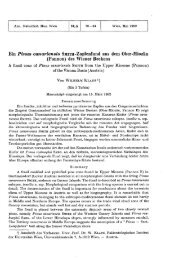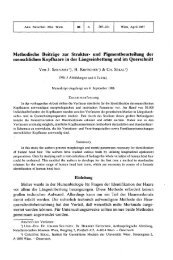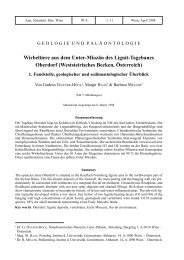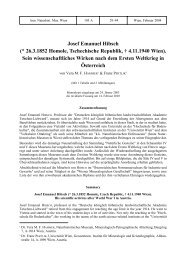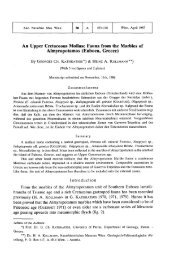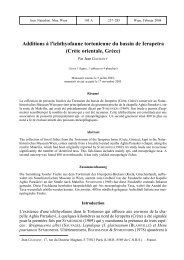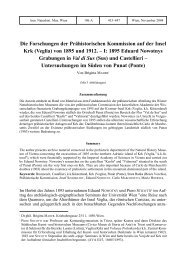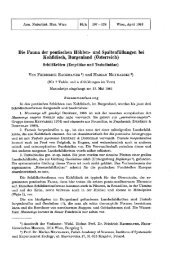Gastropods from the Lower Cretaceous of Vorarlberg, Austria. A ...
Gastropods from the Lower Cretaceous of Vorarlberg, Austria. A ...
Gastropods from the Lower Cretaceous of Vorarlberg, Austria. A ...
Create successful ePaper yourself
Turn your PDF publications into a flip-book with our unique Google optimized e-Paper software.
KOLLMANN: <strong>Gastropods</strong> <strong>from</strong> <strong>the</strong> <strong>Lower</strong> <strong>Cretaceous</strong> <strong>of</strong> <strong>Vorarlberg</strong>. A systematic review 49<br />
Genus Globularia SWAINSON, 1840<br />
Globularia subtilis (COSSMANN)<br />
Plate 4, Figures 54, 55<br />
1918 Ampullospira subtilis COSSMANN, p. 381, textfig. 21<br />
Material. 1 specimen <strong>from</strong> ?Unterklien (GBA: 2002/002/010)<br />
Diemnsions. H: 1.9 mm; B: 1.9 mm; LW: 1.7 mm<br />
Description. Shell small, globular. Spire low, number <strong>of</strong> whorls not evident. Suture <strong>of</strong><br />
last whorl slightly grooved, Last whorl with slight adapical depression, almost totally<br />
overlapping earlier ones.<br />
Aperture broad, angulated adapically. Parietal lip forming umbilical pouch. Columellar<br />
lip low and concave but incomplete.<br />
Remarks. COSSMANN, lit. cit., describes <strong>the</strong> species based on a specimen which is about<br />
3 times larger than that <strong>from</strong> <strong>Vorarlberg</strong>. The specimens agree in <strong>the</strong> adapical depression<br />
on <strong>the</strong> last whorl and <strong>the</strong> pouch, which is only indicated on <strong>the</strong> drawing given by<br />
COSSMANN, lit.cit. The stronger overlap <strong>of</strong> whorls in <strong>the</strong> specimen recorded here may be<br />
due to <strong>the</strong> earlier growth stage. The assignment to Globularia is mainly based on <strong>the</strong><br />
umbilical pouch and <strong>the</strong> adapical depression <strong>of</strong> <strong>the</strong> last whorl.<br />
Distribution. Urgonian facies <strong>of</strong> Orgon, Bouche du Rhône (Barrêmian)<br />
Distribution in <strong>Vorarlberg</strong>. Schrattenkalk Formation<br />
Globularia cf. hugardiana (d´ORBIGNY)<br />
Plate 3, Figure 30<br />
1843 Natica Hugardiana d´ORBIGNY, p. 151, pl. 171, fig. 2<br />
1879 Natica Hugardiana d´ORBIGNY - VACEK, p. 741<br />
1994 Leviathania munieri (CHOFFAT) - CZABALAY, pl. 4, fig. 4<br />
Material. Reference material to VACEK, 1879: 1 internal mould <strong>from</strong> <strong>the</strong> Breiterberg,<br />
close to Bad Haslach (GBA: 1879/01/80)<br />
Dimensions. H: 89.5 ( est.: 95); B: 98.6; LW: 72.6; A: 90°<br />
Description. Mould very large, broad. Early whorls moderately convex, sutural ledges<br />
very broad. Last whorl 8/10 <strong>of</strong> total height, strongly convex, anomphalous. Aperture<br />
very broad, inner lip concave.<br />
Remarks. The mould is that <strong>of</strong> a large anamphalous shell belonging to Globularia<br />
SWAINSON. d´ ORBIGNY, lit. cit., gives a figure <strong>of</strong> a low-spired mould. In fact, all specimens<br />
<strong>of</strong> <strong>the</strong> collection d´ORBIGNY possess higher spires than <strong>the</strong> figured one and <strong>the</strong><br />
specimen <strong>from</strong> <strong>Vorarlberg</strong> agrees in this respect. Because <strong>of</strong> <strong>the</strong> preservation, <strong>the</strong> specific<br />
assignment remains tentative.<br />
Distribution. d´ORBIGNY, 1863, p. 152, recorded <strong>the</strong> species <strong>from</strong> Neocomian deposits<br />
<strong>of</strong> south France. In <strong>the</strong> Haute Savoie and <strong>the</strong> Swiss Jura, PICTET & CAMPICHE, 1862, p.<br />
377, give a Valanginian to ?Hauterivian distribution<br />
Distribution in <strong>Vorarlberg</strong>. Kieselkalk Formation, Gemsmättli Member


